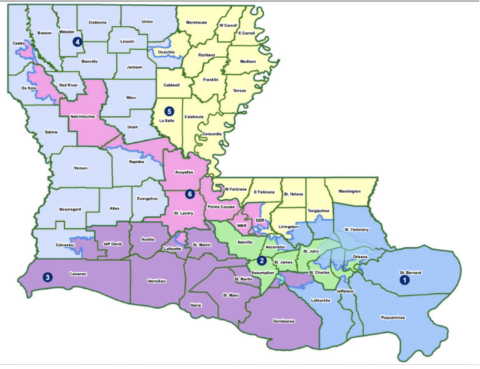Louisiana politicians created an electoral map that returned eight Republican congressmen to only one Democrat, despite the Republicans only getting about two-thirds of the popular vote. Clearly a partisan gerrymander that the courts will set aside … but perhaps not:

District 6, pink on the map, is the second black majority district, a long thin diagonal, stretching about two-thirds of the width and height of the state. It is an obvious gerrymander.
Two thirds of the voters getting eight congressional seats out of nine would be anomalous in a proportional representation system, but US congressional elections are first past the post. If the population of Tennessee were evenly distributed, with the same percentage of Republican and Democratic voters in each congressional district, the majority party would win all of them — even if the division of votes was 51/49. With a majority of almost two to one, the only way the Democrats get any seats is if their voters happen to be concentrated in one or a few districts.
I do not know whether Tennessee districts are actually drawn to favor the Republicans but the facts offered in the article are not evidence of it. Compare the outcome of the most recent UK elections, also under first past the post. Labor got 33.7% of the vote and ended up with 63% of the seats, 411 out of 650.
[…]
The difficulty in the claim that the failure of a group to elect a number of representatives proportional to their share of the vote is nicely illustrated by the litigation, still ongoing, over Louisiana redistricting.
In June 2022, Chief Judge Shelly Dick, an Obama appointee to a federal court in Louisiana, determined that state’s congressional maps were an illegal racial gerrymander. Under the invalid maps, Black voters made up a majority in only one of the state’s six congressional districts, despite the fact that Black people comprise about a third of Louisiana’s population. (Vox)
As best I can tell, no evidence was offered by the court of actual gerrymandering beyond the fact that the percentage of districts with a black majority was less than the percentage of blacks in the population.
After some litigation, the Louisiana legislature drew a new map with two black majority districts — and a new set of plaintiffs sued on the grounds that the new map was a gerrymander drawn to create a black majority district, in violation of the Equal Protection guarantee of the Fourteenth Amendment. They sued in a different federal appeals court and won, a 2 to 1 majority verdict.
One court was insisting that Louisiana had to create a second black majority district to comply with the Civil Rights Act, the other that it could not create such a district, more precisely that it could not create it in the form the legislature had proposed, in order to comply with the Constitution. The case was appealed to the Supreme Court, which let the legislature’s map stand for the 2024 election, about to happen, but has not yet ruled beyond that.
Louisiana, in other words, is now subject to two competing court orders. The first, from Judge Dick, forbids it from using the old maps. The second, from the two Trump judges in the Western District, forbids the state from using the new maps it enacted to comply with Dick’s order. (Vox)



